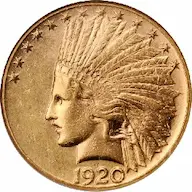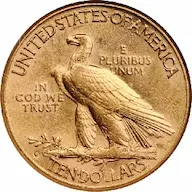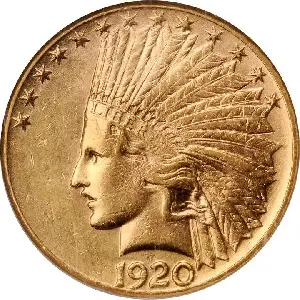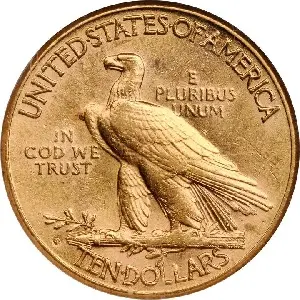1920-S Indian Head $10 Eagle
Theodore Roosevelt is remembered as one of America’s most vibrant presidents. A fearless agent of change, in 1905 Roosevelt commissioned acclaimed sculptor Augustus Saint-Gaudens to elevate the artistic qualities of United States coinage.(1)
Saint-Gaudens died in 1907 but was able to mostly complete designs for just two denominations, the $10 eagle and $20 double eagle, both of which were first issued that same year.
For his $10 design, and at Roosevelt’s urging, Saint-Gaudens added a Native American bonnet to Miss Liberty. Hence the name “Indian Head Eagle” is usually, but inaccurately, applied to this series of coins. The reverse featured a proud eagle astride a bundle of arrows.(2)
The Indian Head $10 eagle was minted from 1907 to 1933, although very sporadically after 1916.
The 1920-S ranks as one of the most elusive of the Indian Head eagle series, right up there with the 1907 Wire Rim, 1907 Rolled Rim, 1930-S, and the 1933.(3)
From the original 1920-S mintage of 126,500, only about 137 examples are known today.(4)
Undoubtedly, nearly all of them perished in the melting pot following President Franklin Roosevelt’s executive order of April 5, 1933, banning private ownership of gold. It also marked the end of gold coin production in the United States, something that had been woven into the fabric of America since 1795.(5)
Roosevelt’s order exempted "gold coins having recognized special value to collectors of rare and unusual coins", but since the 1920-S at that time did not fit this description, it was not spared from the fiery cauldron.
When the “Redbook” was first published in 1947, it was clear the 1920-S was already being respected as one of the major rarities of the 20th century.(6) The near perfect stairstep pattern of price increases since 1990 confirms the 1920-S remains a rock star in the numismatic world.
| Estimated survivors in all grades: 137 ?
The survivor estimate from PCGS represents an average of one or more experts' opinions as to how many examples survive of a particular coin in all grades. Survival estimates include coins that are raw, certified by PCGS, and certified by other grading services. Learn more at PCGS. |
| PCGS Rarity Scale: 7.6 ?
The 'PCGS CoinFacts Rarity Scale' assesses the relative rarity of all U.S. coins, based on estimated surviving examples. The scale runs from 1.0 to 10.0. The higher the number, the rarer the coin.
Learn more at PCGS. |
| Search for the 1920-S Indian Head $10 Eagle on eBay** |
Preview of eBay selection (probably none in this preview, but hit the Search link above to be sure):
 |
 |
| Trendline Avg = 15.85 | GOOD |
 |
 |
| Trendline Avg = 15.85 | GOOD |
Historic Value Trend Charts:
| Last updated 9-6-25 | Return to Key Date Coin List | |
| Compare to Common Date Coin of Same Type | ||
|
|
||
| Download Charts to Your Computer | ||
Sources
1. PCGS. Indian $10.
2. Taxay, Don. The U.S. Mint and Coinage. New York, NY: Sanford J. Durst Numismatic Publications, 1966.
3. Heritage Auctions. 1920-S $10 MS67. Mar 2007 Auction.
4. PCGS. 1920-S $10 (Regular Strike).
5. Wikipedia. Executive Order 6102.
6. Heritage Auctions. 1920-S $10 MS67. Mar 2007 Auction.
**Many very fine coin dealers sell on eBay. At any point in time, there may be over one million search results for United States coins. This includes quite a few of the recommendations on our Key Date Coin List.
If you’re thinking about purchasing a rare coin, eBay is certainly worth a look. For your convenience, the links from this site to eBay are coded to bring up only coins certified by PCGS and NGC.
As is always, always the case, never buy a valuable coin from a seller whose trustworthiness cannot be verified. Learn more about this at our chapter Best Places to Buy Coins, which also has a section on doing business on eBay.
In the interest of full disclosure, Rare Coins 101 receives a small commission anytime someone connects to eBay from this site and purchases something.
Coin images by Stack's Bowers Galleries.


